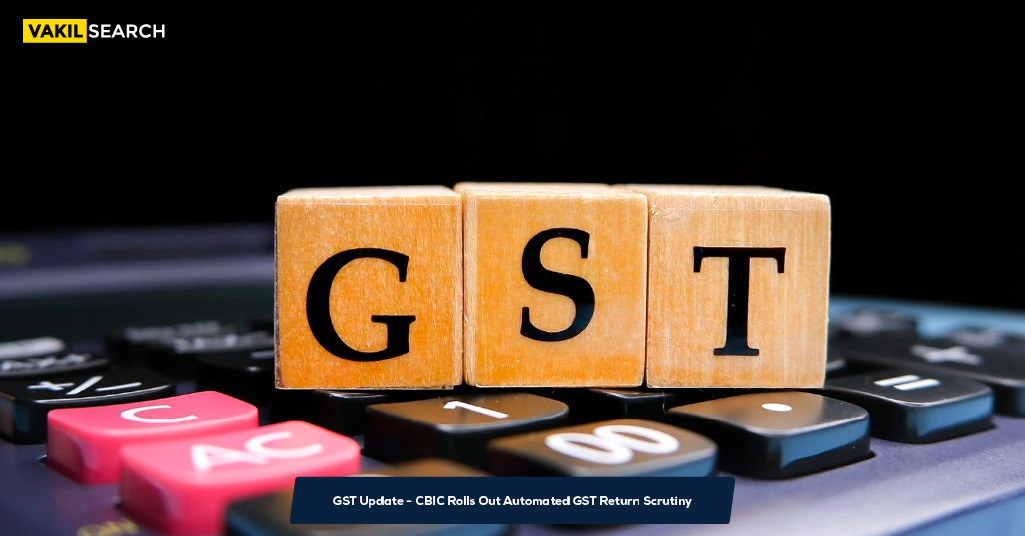Stay ahead with CBIC's latest GST update: Introducing automated scrutiny of GST returns. Enhance compliance and streamline your processes.
Introduction
The Central Board of Indirect Taxes & Customs (CBIC) has recently introduced an Automated Return Scrutiny Module for GST returns. This module aims to streamline the process of scrutinizing GST returns for Centre Administered GST Taxpayers. With the help of data analytics and risk identification, the system will select returns that require scrutiny. This module provides an efficient and non-intrusive means of compliance verification for tax officers.
What is the Automated Return Scrutiny Module?
The Automated Return Scrutiny Module is a software application integrated into the ACES-GST back-end system used by Central Tax Officers. Its purpose is to identify and display discrepancies in GST returns based on risk factors. By using this module, tax officers can effectively scrutinize the returns of Centre Administered GST Taxpayers.
How Does It Work?
The module analyzes the data provided in the GST returns and identifies potential risks and discrepancies. The system then presents these discrepancies to the tax officers for further examination. Using the GSTN Common Portal, tax officers can communicate the identified discrepancies to the taxpayers through a form called FORM ASMT-10.
Taxpayers, upon receiving the intimation, can respond by submitting their clarification through FORM ASMT-11. The tax officers, after reviewing the taxpayer’s response, can take appropriate action. This may involve issuing an order of acceptance of the reply (FORM ASMT-12) if the explanation provided is satisfactory. Alternatively, the officers may choose to issue a show cause notice or initiate an audit or investigation.
Implementation and Scope
The implementation of the Automated Return Scrutiny Module for GST returns has started with the scrutiny of GST returns for the financial year 2019-20. This means that the module is currently being used to analyze and identify discrepancies in the returns filed by Centre Administered GST Taxpayers for that specific period.
The necessary data for this purpose has already been made available on the officers’ dashboard. This data includes the GST returns filed by taxpayers, which are analyzed using data analytics and risk identification techniques. The module selects returns based on predetermined risk factors, allowing tax officers to focus their scrutiny on high-risk cases.
The scope of this module covers Centre Administered GST Taxpayers, which means it applies to taxpayers who fall under the jurisdiction of the Central Tax Officers. The module aims to facilitate compliance verification for these taxpayers by automating the process of scrutinizing their GST returns.
By starting with the scrutiny of GST returns for the financial year 2019-20, the CBIC aims to assess the effectiveness of the module and make any necessary refinements before expanding its scope to cover additional tax periods. It is expected that in the future, the module will be implemented for scrutinizing GST returns of subsequent financial years as well.
The implementation of this module demonstrates the CBIC’s commitment to leveraging technology and data-driven approaches to improve tax compliance and streamline administrative processes. The scope may be further expanded in the future to include more taxpayers and tax periods, based on the success and effectiveness of the module. Get in touch with our experts and tap Talk to CA
Benefits of the Automated Return Scrutiny Module
- Increased Efficiency: The module utilizes data analytics to identify potential risks and discrepancies, allowing tax officers to focus their attention on high-risk returns. This saves time and resources while improving the efficiency of the scrutiny process.
- Non-Intrusive Compliance Verification: The module offers a non-intrusive approach to compliance verification, reducing the need for intrusive and time-consuming manual scrutiny methods.
- Timely Communication: The module facilitates seamless communication between tax officers and taxpayers through the GSTN Common Portal. This ensures that discrepancies are promptly addressed and resolved, promoting transparency and reducing compliance-related delays.
- Fairness and Accuracy: The automated system uses data-driven analysis to identify discrepancies, ensuring a fair and unbiased scrutiny process. By relying on objective risk factors, the module reduces the chances of human error and subjectivity.
When will the Automated Return Scrutiny Module be Implemented?
The automated return scrutiny module has already begun, with the examination of GST returns for the fiscal year 2019-20. The necessary data for this purpose is now available on the dashboards of tax officers.
What are the various Risk Parameters for GST Returns being subjected to Scrutiny?
The risk parameters for automated GST return scrutiny are as follows –
- Mismatch between the data declared in GST returns and the summary GST return or statement of input tax credit.
- Claiming Input Tax Credit (ITC) after the effective date of cancellation of registration of a supplier.
- Availing ITC for invoices and debit notes issued by suppliers who have not filed their GSTR-3B returns.
- Filing GSTR-3B after the deadline for claiming ITC as per Section 16(4) of the CGST Act.
- Non-reversal of ITC as per Rule 42 and Rule 43 of the CGST Rules.
- Failure to pay interest as per Section 50 of the CGST Act.
- Non-payment of late fees as per Section 47 of the CGST Act.
How will Automated Return Scrutiny impact GST Taxpayers?
The implementation of automated return scrutiny in the GST system increases the likelihood of taxpayers receiving scrutiny and demand notices for even minor errors or discrepancies. Previously, it was at the discretion of tax officers to issue such notices, but now the system automatically detects mismatches exceeding tolerance limits set by the GSTN.
This puts an added responsibility on taxpayers to ensure accurate data reconciliation before filing returns and to maintain proper documentation and evidence for the current year and the past four years. Failure to do so may result in difficulties in proving the absence of tax evasion intent, leading to potential interest and penalties.
To avoid being targeted by the automated scrutiny system, taxpayers must prioritize regular data reconciliations and maintain a comprehensive audit trail. Taking proactive measures before filing returns is crucial for safeguarding against unnecessary financial consequences.
Actions Available for Taxpayers Subjected to Scrutiny
Taxpayers who receive notice in Form ASMT-10 are required to respond by submitting a reply in Form ASMT-11 within thirty days or within the timeframe allowed by the officer. The communication between officers and taxpayers is conducted electronically to maintain a faceless approach, and all documents or statements should be submitted as softcopies on the designated portal.
In the reply (ASMT-11), taxpayers have the option to accept the difference and make the necessary tax payments using form DRC-03 for tax, interest, or dues. If the reply is found satisfactory, the officer may issue an order in Form ASMT-12 to drop the proceedings, relieving the taxpayer from further action.
However, if the taxpayer fails to reply within the specified timeframe or if the reply is found unsatisfactory, the officer may initiate proceedings by sending a show cause notice under Sections 73/74 or consider conducting audits/investigations with the necessary permissions. In such cases, taxpayers are expected to cooperate with the officer and provide full disclosure of information related to the relevant financial year.
Checklist for Tax Filers to avoid Automated Return Scrutiny
Tax filers must ensure they follow a comprehensive checklist while filing GST returns to adhere to the system of automated return scrutiny. Some important points to consider include:
- Match tax liabilities in GSTR-3B with the corresponding tables in GSTR-1.
- Accurately report and adjust advances in GSTR-1 and GSTR-3B.
- Pay the exact tax liability under the reverse charge mechanism and claim eligible ITC.
- Match ITC claimed in GSTR-3B with eligible ITC in GSTR-2A.
- Ensure sales subject to TCS or TDS match the credit reflected in GSTR-2A.
- Verify tax liabilities in GSTR-3B with corresponding e-way bills.
- Do not claim ITC for ineligible periods after the cancellation of suppliers’ GST registrations.
- Verify the filing status of vendors in GSTR-3B before claiming ITC.
- Avoid claiming ITC if GSTR-3B is filed after the deadline under Section 16(4) of the CGST Act.
- Match ITC on the import of goods in GSTR-3B with GSTR-2A and ICEGATE data.
- Follow CGST Rules 42 and 43 for accurate ITC reversals.
- Make timely late fee and interest payments as per the CGST Act.
- Reconcile sales register and general ledger for accurate tax reporting.
- Reconcile e-invoices from the IRP with draft GSTR-1 and sales register.
- Note that additional checklist items may apply depending on the industry.
Following this checklist will help taxpayers ensure accuracy in their GST returns and minimize the risk of scrutiny and penalties under the automated return scrutiny system.
FAQs
How do I Scrutiny GST Returns?
GST scrutiny is a process by which the GST authorities review your GST returns to ensure that they are accurate and compliant with the law. The GST authorities may scrutinize your returns for a variety of reasons, such as: To verify the accuracy of your GST liability To check for compliance with the GST law To identify potential tax evasion If your GST returns are selected for scrutiny, the GST authorities will issue you a scrutiny notice. The scrutiny notice will specify the details of the information that the GST authorities require from you. You will need to provide the requested information to the GST authorities within the specified time period.
What is the time limit for GST scrutiny?
The time limit for GST Scrutiny is not defined.
How do I respond to a GST Scrutiny notice?
If you have received a GST scrutiny notice, carefully review the notice and provide the requested information to the GST authorities within the specified time period. Ensure that you retain a copy of the scrutiny notice and all of the documents that you provide to the GST authorities.
Which section for scrutiny of returns in GST?
The section for scrutiny of returns in GST is Section 61 of the CGST Act, 2017. This section empowers the GST authorities to scrutinize GST returns filed by taxpayers.
What is the time limit for scrutiny notice?
The time limit for replying to a scrutiny notice is 30 days from the date of the notice. However, the time limit may be extended to the satisfaction of the officer.
What is scrutiny of returns in GST section 61?
Section 61 of the CGST Act, 2017 provides for the scrutiny of GST returns. The GST authorities may scrutinize GST returns to verify the accuracy of the information contained in the returns and to ensure that the returns are compliant with the GST law.
How do I resolve a query in GST?
If you have a query about GST, you can contact the Vakilsearch experts or you can submit an online query through the chat box. Our experts will respond to your query within a reasonable time period.
What is scrutiny assessment under GST?
Scrutiny assessment is a type of GST assessment that is conducted by the GST authorities to verify the accuracy of the information contained in your GST returns. The GST authorities may conduct a scrutiny assessment if they have any concerns about the accuracy of your returns.
What is the time limit for GST Assessment?
The final GST Assessment is to be done within 6 months of the provisional assessment.
What is return Scrutiny?
Return scrutiny is the process of reviewing GST returns to ensure that they are accurate and compliant with the GST law.
What is scrutiny assessment under section 143 subsection 3?
Section 143(3) of the CGST Act, 2017 provides for a situation where the inputs sent for job work are not received back by the principal after completion of job work or are not supplied from the place of business of the job worker in accordance with the provisions of clause (a) of sub-section (1) or clause (b) of sub-section (1).
What is Scrutiny of Tax returns?
Scrutiny of tax returns is the process of reviewing tax returns to ensure that they are accurate and compliant with the tax law.
Conclusion
The introduction of the Automated Return Scrutiny Module for GST returns marks a significant milestone in simplifying tax compliance. This module leverages technology and data analytics to streamline the scrutiny process, making it more efficient, non-intrusive, and fair. By enhancing compliance verification, this system benefits both taxpayers and tax officers, promoting transparency and reducing the compliance burden. Get in touch with Vakilsearch today!










